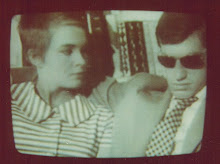Tamra Davis was a friend of JMB and filmmaker in downtown New York City during the 1980s. She and Becky Johnson interviewed him at L'Hermitage Hotel in Hollywood durng 1985. He was just 25 and at the top of his career as a painter. Two years later he died. Tamra put away all the film footage for twenty years.
Her "racialiscious" film (says the webpage) is full significant interviews with artworld folks, friend and lovers. It paints a picture of late 1970s and early 1980s Manhattan when it was still affordable for young art students, runaways and lost personalities to assemble. Part Puerto Rican, part Haitian, Jean-Michel arrived in the city with no money and a lot of creative spirit to mark the artworld. The film implies that there were about 500 people in the downtown art scene of the time. Jean-Michel was a grafitti artist who tagged walls around SoHo with content-laden/poetic messages signed by SAMO (same old shit--clearly directed to the art world).
"He was one of the people I was truly envious of, but he was too fragile for this world," says Madonna. He had a band called GRAY, including one Vincent Gallo, now an actor/film director (Buffalo 66). Jean Michel made collage cards and paint splattered t-shirts that he sold on the street. One commentator mentioned a characteristic of a good artist is a sure strong hand, something that JMB had plenty of.
Glenn O'Brien was involved with the making of the film Downtown 81, about the scene below Canal Street...starring JMB as the ambitious young artist. It was during that time that he was encouraged to take his grafitti off the streets onto a canvas. Debbie Harry of Blondie was his first big sale. She bought one of the canvases for $200.
JMB participted in The Times Square Show, the first radical show of the 1980s, with more than a hundred artists showing their work. Jean-Michel's good pals, Keith Haring and Kenny Scharf also showed in the TSS. Following that was the No-Wave Show at PS1 in 1981. Diego Cortez curated it, tired of seeing white walls, white people and white wine.
Annina Nosei discovered Jean-Michel's work at this exhibition and was taken by it's sophistication, despite the primitive appearance. She offered him the use of her Prince Street Gallery's basement as a studio and encouraged him to make large canvases for a show. He listened to Ravel's "Bolero" over and over, though his music tastes were eclectic and he also had a passion for Jazz. It drove Annina a little crazy, but JM was prolific and productive. Her gallery show made him an instant art star.
Fame came fast and JM found refuge with Andy Warhol, who bacame a paternal influence and mentor. JM kept working in unexpected ways. He created his own versions of famous paintings and had an ongoing desire to compete with living legends such as Julian Schnabel. Andy Warhol befriended him, leading to a close paternal/mentor relationship relationship. When Andy died unexpectedly after gall baldder surgery, Jean Michel was distraught and began a downward spiral of drug use.
Annina Nosei considered his last works to be masterpieces...spacious and loose. His sudden death at age 27 was a great loss to the art world, but he had already produced 1000 paintings and 1000 drawings. His work was selling for 14.5 million. This film tell a wonderful story of artistic genius during a special time in the history of New York art.
12/19/10
Subscribe to:
Post Comments (Atom)





No comments:
Post a Comment